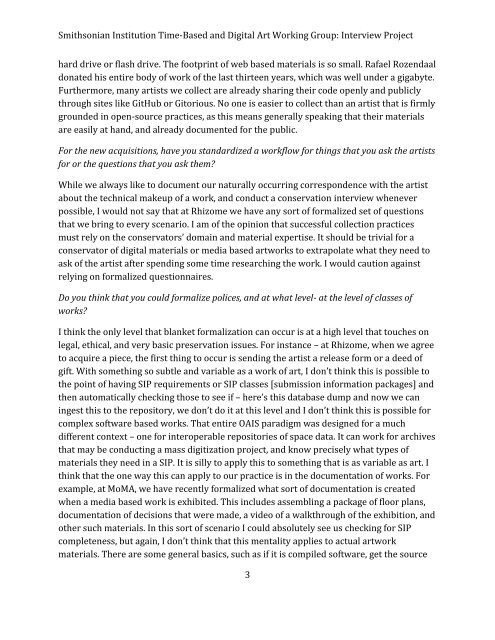Ben Fino-Radin - Smithsonian Institution
Ben Fino-Radin - Smithsonian Institution
Ben Fino-Radin - Smithsonian Institution
Create successful ePaper yourself
Turn your PDF publications into a flip-book with our unique Google optimized e-Paper software.
<strong>Smithsonian</strong> <strong>Institution</strong> Time-Based and Digital Art Working Group: Interview Project<br />
hard drive or flash drive. The footprint of web based materials is so small. Rafael Rozendaal<br />
donated his entire body of work of the last thirteen years, which was well under a gigabyte.<br />
Furthermore, many artists we collect are already sharing their code openly and publicly<br />
through sites like GitHub or Gitorious. No one is easier to collect than an artist that is firmly<br />
grounded in open-source practices, as this means generally speaking that their materials<br />
are easily at hand, and already documented for the public.<br />
For the new acquisitions, have you standardized a workflow for things that you ask the artists<br />
for or the questions that you ask them?<br />
While we always like to document our naturally occurring correspondence with the artist<br />
about the technical makeup of a work, and conduct a conservation interview whenever<br />
possible, I would not say that at Rhizome we have any sort of formalized set of questions<br />
that we bring to every scenario. I am of the opinion that successful collection practices<br />
must rely on the conservators’ domain and material expertise. It should be trivial for a<br />
conservator of digital materials or media based artworks to extrapolate what they need to<br />
ask of the artist after spending some time researching the work. I would caution against<br />
relying on formalized questionnaires.<br />
Do you think that you could formalize polices, and at what level- at the level of classes of<br />
works?<br />
I think the only level that blanket formalization can occur is at a high level that touches on<br />
legal, ethical, and very basic preservation issues. For instance – at Rhizome, when we agree<br />
to acquire a piece, the first thing to occur is sending the artist a release form or a deed of<br />
gift. With something so subtle and variable as a work of art, I don’t think this is possible to<br />
the point of having SIP requirements or SIP classes [submission information packages] and<br />
then automatically checking those to see if – here’s this database dump and now we can<br />
ingest this to the repository, we don’t do it at this level and I don’t think this is possible for<br />
complex software based works. That entire OAIS paradigm was designed for a much<br />
different context – one for interoperable repositories of space data. It can work for archives<br />
that may be conducting a mass digitization project, and know precisely what types of<br />
materials they need in a SIP. It is silly to apply this to something that is as variable as art. I<br />
think that the one way this can apply to our practice is in the documentation of works. For<br />
example, at MoMA, we have recently formalized what sort of documentation is created<br />
when a media based work is exhibited. This includes assembling a package of floor plans,<br />
documentation of decisions that were made, a video of a walkthrough of the exhibition, and<br />
other such materials. In this sort of scenario I could absolutely see us checking for SIP<br />
completeness, but again, I don’t think that this mentality applies to actual artwork<br />
materials. There are some general basics, such as if it is compiled software, get the source<br />
3
















